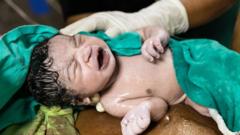Last year, India surpassed China, becoming the world's most populous country with approximately 1.45 billion residents. Contrary to expectations, discussions about increasing the birth rate have intensified, particularly in southern states like Andhra Pradesh and Tamil Nadu, which are exploring incentives to boost family sizes due to low fertility rates and an aging populace.
India has witnessed a significant decline in fertility rates, from 5.7 births per woman in 1950 to around two today, with 17 out of 29 states and territories falling below the replacement level of two births per woman. The five southern states have been at the forefront of this demographic transition, achieving replacement-level fertility rates ahead of their northern counterparts. As a result, Andhra Pradesh and Tamil Nadu are re-evaluating policies that limit childbearing, with Andhra Pradesh recently abolishing its "two-child policy" related to local elections.
Concerns loom for these southern states as they face the first delimitation of electoral seats since 1976 in 2026, which could restructure boundaries based on population distribution. Analysts predict that populous northern states like Uttar Pradesh and Bihar could gain parliamentary representation, while more prosperous southern states may face reductions, amplifying fears about equitable federal revenue sharing.
Demographers caution that rapid aging in India, driven by falling fertility rates, poses substantial challenges. While countries like France took over a century to double their aging population, India is projected to reach this landmark in a mere 28 years. Unlike other nations that see a natural decline in fertility alongside socio-economic advancements, India's fertility drop is attributed to robust family welfare policies that pushed for smaller families.
The financial burden of a rapidly aging population exacerbates the predicament for these southern states. Currently, over 40% of elderly Indians belong to the poorest wealth quintile, raising concerns about the sustainability of social security and healthcare systems. Furthermore, urbanization and migration trends are eroding traditional family support structures which have historically cared for the elderly.
The call for higher birth rates gained momentum when Mohan Bhagwat, the chief of the Rashtriya Swayamsevak Sangh, urged couples to have at least three children, citing fears over population decline. While some demographers warn against the potential consequences of declining fertility, suggesting that rates below 1.6 could lead to rapid population decline, they argue the societal shifts, including improved gender equality, are likely to maintain current trends.
Countries facing similar demographic challenges, like South Korea and Greece, are attempting to address low birth rates through policy reforms. In contrast, India must focus on maximizing its demographic dividend—growing opportunities for jobs among a large working-age population—while also ensuring policies promote healthy aging in the workforce. The demographic window of opportunity for India is projected to last until 2047, urging immediate action to bolster economic growth and resource allocation for an aging society.



















